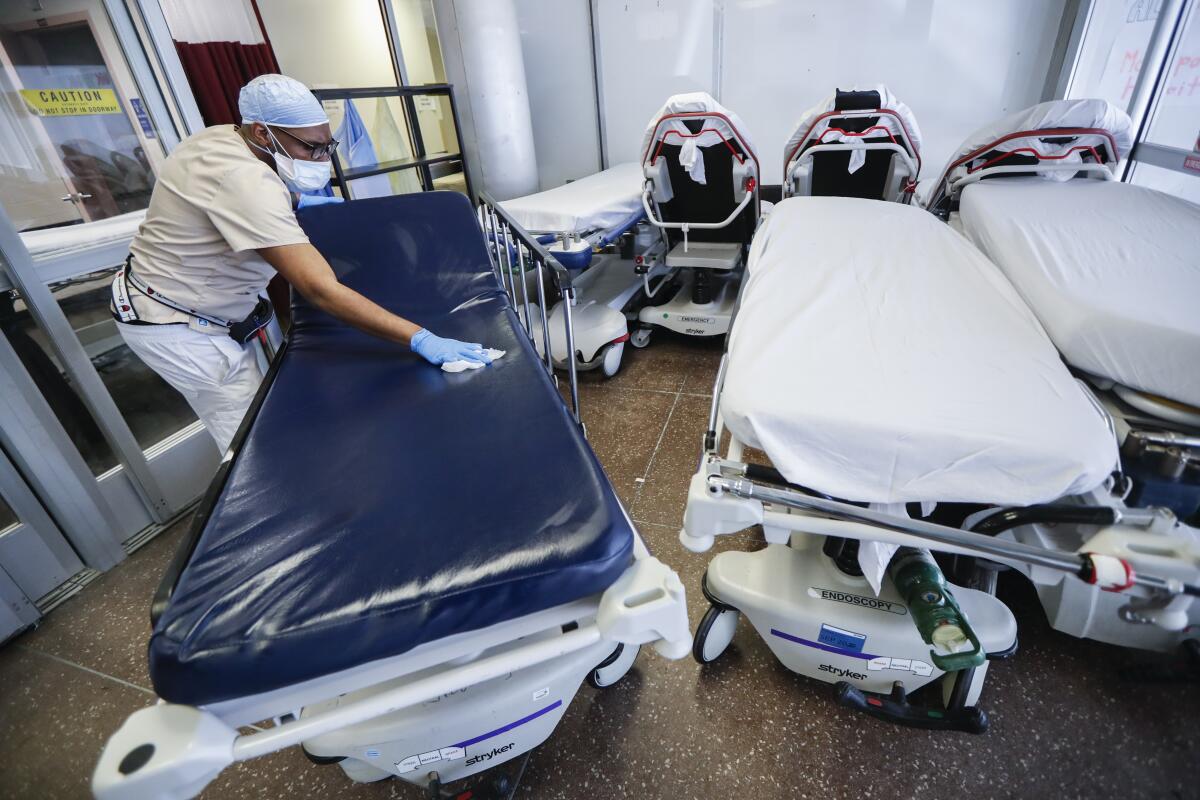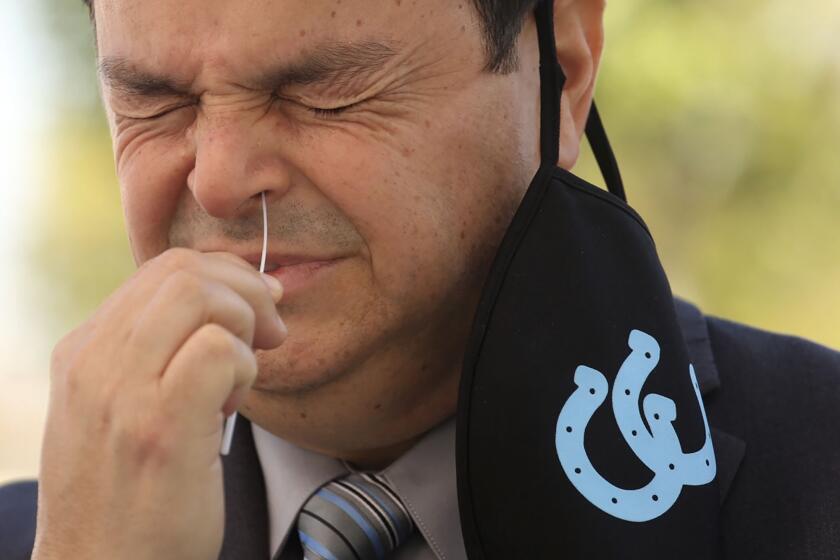Coronavirus data is funneled away from CDC, sparking worries

- Share via
NEW YORK — Hospital data related to the coronavirus pandemic in the U.S. will now be collected by a private technology firm rather than the Centers for Disease Control and Prevention — a move the Trump administration says will speed up reporting but one that concerns some public health leaders.
Dr. Robert Redfield, the CDC director, said Wednesday that he’s fine with the change — even though some experts fear it will further sideline the agency in the national response to the COVID-19 pandemic.
The CDC has agreed to step out of the government’s traditional data collection process “in order to streamline reporting,” Redfield said during a call with reporters set up by the agency’s parent, the U.S. Department of Health and Human Services.
HHS officials recently posted a document on the agency’s website that redirected hospitals’ daily reporting of a range of data meant to assess the impact of the coronavirus on them. TeleTracking Technologies, based in Pittsburgh, will now collect that information.
However, if hospitals are already directly reporting to state health departments, they can get a written release from the state to keep doing that.
The information includes bed occupancy, staffing levels, the severity level of coronavirus patients, ventilators on hand, and supplies of masks, gowns and other personal protective equipment. The CDC will continue to collect other data, like information about cases and deaths, from state health departments.
Michael Caputo, an HHS spokesman, said the CDC has been seeing a lag of a week or more in data coming from hospitals and that only 85% of hospitals have been participating. The change is meant to result in faster and more complete reporting, he said.
It’s not clear how that will happen. HHS officials on Wednesday did not answer questions about whether there would be added government incentives or mandates to get more reporting from busy hospitals.
A CDC official who is familiar with the agency’s system disputed Caputo’s figures, saying only about 60% of the nation’s hospitals have been reporting to the CDC system, but most data is collected and reported out within two days. The official spoke on condition of anonymity because he was not authorized to talk about it.
COVID-19 claims the lives of Black and Latino Americans earlier than it does for whites. Nonwhite victims are typically a decade younger than whites, the CDC says.
The CDC’s National Healthcare Safety Network system was launched 15 years ago and is perhaps best known for its work gathering, and publicly reporting, data on hospital infections. It has helped drive a successful push to reduce certain kinds of hospital infections.
The system started doing COVID-19 data collection in March. Two other systems have been put in place since, one involving hospitals reporting directly to states and the other the TeleTracking system.
Administration officials put incentives in place to encourage hospitals to report through the other systems, the official said. For instance, the coronavirus treatment drug remdesivir was sometimes allocated to hospitals based on whether they used TeleTracking.
Some outside experts expressed suspicion and concern about the decision to drop the CDC from the data collection mix.
The data “are the foundation that guide our response to the pandemic,” Dr. Thomas File Jr., president of the Infectious Diseases Society of America, said in a statement.
Collecting and reporting public health data has always been a core function of the CDC, he added. “The administration should provide funding to support data collection and should strengthen the role of CDC to collect and report COVID-19 data,” he said.
Gregory Koblentz, a biodefense expert at George Mason University, said the change appears to be consistent with administration moves in recent months that have sidelined the CDC from the role it has played in other epidemics as the public’s primary source of information.
“We know the administration has been trying to silence the CDC,” he said. “Now it looks like the administration might be trying to blind the CDC as well.”
The White House directed a request for comment to the Health and Human Services Department.
Redfield, the CDC director, said the agency would retain access to all the data. He also said the change would enable it to focus on collecting other data, like information from nursing homes.
Still, his predecessor, Dr. Tom Frieden, expressed dismay at the decision.
“Rather than strengthening the CDC public health data system to improve hospital reporting, the administration has handed data to an unproven, commercial entity,” said Frieden, who was the agency’s director during the Obama administration.
The CDC has added six new symptoms to its list of signs that a person has been infected with the new coronavirus, including chills and loss of sense of smell.
In April, the government awarded a $10.2-million contract to TeleTracking. At the time, the company was hired to gather data on things that were already being reported to the CDC, such as available hospital beds.
TeleTracking has won 29 contracts for federal government work stretching back to 2004. None of its previous contracts paid more than $300,000. The prior contracts were for computer systems and programming at Veteran Affairs hospitals.
The company has also gotten approval to tap a government loans program designed to help small business keep employees on their payroll during the pandemic. The forgivable loan was from the Payroll Protection Program for between $5 million and $10 million. TeleTracking indicated it planned to use the loan to help save the jobs of some of its 376 workers.
TeleTracking did not immediately respond to requests for comment.
The chief executive of Teletracking, Michael Zamagias, also runs a real estate investment firm with several properties in Pittsburgh. One of his companies, Michael G. Zamagias Interests Ltd., was approved for a Payroll Protection Program loan of between $150,000 and $350,000.
More to Read
Sign up for Essential California
The most important California stories and recommendations in your inbox every morning.
You may occasionally receive promotional content from the Los Angeles Times.














